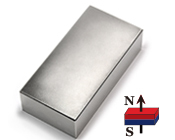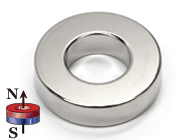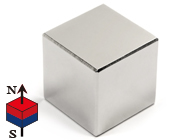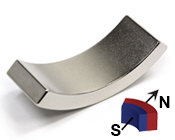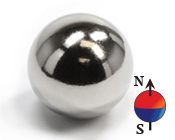There are no products listed under this category.
Shop By Category
- Hot Deal
-
Neodymium Magnets
- Neodymium Magnets
-
DISC Magnets
- DISC Magnets
- Disc Neodymium Magnets Diameter <= 1/4"
- Disc Neodymium Magnets 1/4 < Diameter <= 1/2"
- Disc Neodymium Magnets 1/2 < Diameter <= 1"
- Disc Neodymium Magnets Diameter > 1"
- Cylinder Magnets
- Diametrically Magnetized Magnets
- Countersunk Disc Magnets
- Adhesive Disc Magnets
- Plastic Coated Disc Magnets
- Steel Magnet Strikers
- BAR Magnets
- RING Magnets
- CUBE Magnets
- ARC Magnets
- WEDGE Magnets
- Magnet Sphere
- N52 Neodymium Magnets
- CERAMIC Magnets
- SmCo Magnets
- ALNICO Magnets
- Cup & Pot Magnets & Magnetic Bases
-
Home Magnets
- OFFICE Magnets
- Industrial Magnets
- Magnet Wires
- Neodymium Magnets Catalog
- Amazon Neodymium Magnets
- Custom Made Magnets
- WIND POWER - Blades
Shop By Brand
- Neodymium Magnets
-
DISC Magnets
- DISC Magnets
- Disc Neodymium Magnets Diameter <= 1/4"
- Disc Neodymium Magnets 1/4 < Diameter <= 1/2"
- Disc Neodymium Magnets 1/2 < Diameter <= 1"
- Disc Neodymium Magnets Diameter > 1"
- Cylinder Magnets
- Diametrically Magnetized Magnets
- Countersunk Disc Magnets
- Adhesive Disc Magnets
- Plastic Coated Disc Magnets
- Steel Magnet Strikers
- BAR Magnets
- RING Magnets
- CUBE Magnets
- ARC Magnets
- WEDGE Magnets
- Magnet Sphere
- N52 Neodymium Magnets
Shop By Brand
Neodymium Magnets
Neodymium Magnets: Comprehensive Catalog for Professional Applications
Explore our extensive selection of Neodymium Magnets, featuring high-grade, NdFeB magnets designed for a range of industrial, technological, and commercial applications. Our inventory ensures precise solutions for every requirement.
Key Advantages of Our Neodymium Magnets:
Expansive Range: With over 2,300 variants, our product line includes magnets tailored for specific operational needs across diverse industries.
Customization Services: For applications with unique specifications, we offer custom magnet fabrication. This includes magnets of distinct sizes or with specific temperature resistance capabilities.
Technical Specifications:
- Grades: Available from N35 to N52, allowing selection based on magnetic strength requirements.
- Magnetic Flux Densities: Range from 11,500 to 14,400 Gauss, ensuring high-performance outcomes.
- Energy Products: Span from 35 to 52 MGOe, indicative of the magnets' efficiency and operational effectiveness.
Coatings and Durability:
- Standard Coating: A Ni+Cu+Ni triple layer is applied to each magnet for enhanced longevity and corrosion resistance.
- Alternative Coatings: Options such as epoxy, plastic, and rubber are available for specific environmental applications or aesthetic considerations.
Design and Features:
- Shape Variety: Our selection includes diverse geometries like discs, blocks, and cylinders, accommodating broad application needs.
- Functional Enhancements: Features such as countersunk holes, pre-applied adhesive, and stainless-steel coverings simplify integration and installation.
- Magnet Kits: For comprehensive requirements, we offer sets complete with compatible accessories for immediate application.
Custom Neodymium Magnet Orders:
We understand that some projects require highly specific magnetic solutions. Our team is equipped to develop custom neodymium magnets, meticulously designed to meet precise application standards.
Leverage Neodymium Magnet Technology:
Our focus is on providing neodymium magnets that support innovation and efficiency across various sectors. We are committed to delivering products that not only meet but exceed professional standards.
Find the Optimal Neodymium Magnet:
For applications demanding strong magnetic performance, explore our selection of neodymium magnets. Contact us for a consultation on custom solutions or to find a product that aligns with your technical requirements.
1. Introduction to Neodymium Magnets
Neodymium magnets, also referred to as NdFeB or Rare Earth magnets, are distinguished by their exceptional magnetic strength and utility in various technological applications. As the most potent class of permanent magnets, they play a crucial role in a number of sectors due to their superior magnetic capabilities.
Composition and Structural Attributes:
These magnets are a subset of the rare earth magnet family, which also encompasses Samarium Cobalt (SmCo) magnets. Comprised of neodymium (Nd), iron (Fe), and boron (B), their unique crystalline arrangement provides the foundation for their extraordinary magnetic performance.
Magnetic Strength and Grading:
Neodymium magnets are known for their high magnetic strength, surpassing all other permanent magnets in the market. They are classified into various grades, such as N35 and N52, with the grade number reflecting the magnet's maximum energy product. The N52 grade, for example, represents a magnet with a maximum energy product of 51-53 MGOe, indicating a high level of magnetic strength.
Applications:
Neodymium magnets' versatility allows for their application across diverse industries, including:
- Electronics: Utilized in audio devices for converting electrical signals into sound.
- Medical Technology: Essential in MRI machines for detailed imaging.
- Automotive Industry: Employed in electric vehicle motors and sensory systems.
- Renewable Energy: Critical in wind turbines for energy conversion.
- Data Storage: Used in computer hard drives for efficient data processing.
- Industrial Equipment: Applied in machinery such as conveyor systems and magnetic separators.
- Consumer Electronics: Incorporated into household devices for enhanced functionality.
Handling and Safety Considerations:
Given their intense magnetic strength, Neodymium magnets require careful handling to mitigate risks associated with their powerful attraction. Precautions include avoiding proximity to electronic devices and ensuring controlled manipulation to prevent injuries.
2. Assessing the Strength of Neodymium Magnets
Neodymium Magnets: A Paradigm of Magnetic Force
Recognized as the paramount in permanent magnet strength, Neodymium magnets exhibit a magnetic force superior to any other type of permanent magnet available. This significant force is attributable to their unique composition of neodymium, iron, and boron, which provides these rare earth magnets with unparalleled magnetic capabilities.
These magnets outperform traditional magnet types, such as ceramic or Alnico, in terms of strength. The magnet grades, represented as N35, N52, etc., denote the maximum energy product, with higher numbers indicating a magnet of greater strength. Specifically, an N52 grade magnet exemplifies one of the most potent forces within this category, essential for high-demand applications.
The critical role of Neodymium magnets across diverse sectors, including electronics, medical devices, automotive, renewable energy, underscores their importance in enhancing efficiency and performance.
3. Variations in Neodymium Magnet Grades
Neodymium Magnet Grades: Tailored Magnetic Strengths
Neodymium magnets are distinguished not only by their strength but also by the variety of grades available, each suited to specific applications. These grades are marked by an "N" followed by numerals, spanning from N35 to N52 and beyond, each indicating a unique set of magnetic properties.
- N35 Grade: Suits general applications, offering sufficient magnetic strength for crafting and DIY projects.
- N42 Grade: Provides a cost-effective solution with adequate strength for sensors and magnetic therapy devices.
- N45 to N50 Grades: These grades cater to more rigorous applications, such as securing heavy cabinet doors or enhancing medical and industrial devices.
- N52 Grade: This grade stands at the apex of commercial magnetic strength, ideal for applications in wind turbine generators and advanced technological developments.
Additionally, custom grades are available to meet precise industrial specifications, ensuring an optimal match for every application requirement.
4. Coercive Force Comparison of Neodymium Magnets
Neodymium Magnets: Superior Resistance to Demagnetization
The intrinsic coercive force of Neodymium magnets, indicative of their resistance to demagnetization, surpasses that of many other magnetic materials. This property is critical for applications that demand long-lasting magnetic performance under extreme conditions.
Compared to other magnet materials such as Ferrite or Alnico, which may have their advantages in cost or thermal stability, Neodymium magnets offer unmatched coercive strength. This makes them indispensable in applications where magnetic performance must withstand demanding environmental conditions, such as in electric motors and digital data storage solutions.
5. Applications of Neodymium Magnets in Various Industries
Neodymium magnets, characterized by their significant magnetic strength, are indispensable across a wide range of industrial, technological, and consumer applications. Key uses include:
- Electronics: Integral to the miniaturization and functionality enhancement of devices such as smartphones and audio equipment.
- Healthcare: Utilized in magnetic therapy for pain management and in MRI machines for advanced medical imaging.
- Automotive: Critical in the operation of electric vehicle motors, steering systems, and sensor technology, contributing to automotive innovation.
- Industrial Machinery: Enhances efficiency and reliability in equipment like conveyor systems and magnetic separators.
- Renewable Energy: Facilitates the generation of clean energy in wind turbines through efficient wind-to-electricity conversion.
- Crafting and DIY: Offers versatility for creative projects, including magnetic closures and decorative installations.
- Aerospace: Applied in navigational, sensing, and actuation systems within aerospace engineering.
- Modeling and Hobby: Enables detailed customization and functionality in model building and hobbies.
- Security Systems: Provides foundational technology for alarm systems and access control.
- Educational Tools: Aids in the demonstration of magnetic principles and in scientific experimentation.
- Home Improvement: Improves daily living through applications in cabinet closures, magnetic holders, and more.
- Scientific Research: Supports exploration and experimentation in studies related to magnetic fields.
6. Manufacturing Process of Neodymium Magnets
The production of neodymium magnets, known for their superior magnetic properties, involves a complex and precise series of steps:
- Extraction: Mining of rare-earth minerals containing Neodymium.
- Refinement: Processing to extract Neodymium oxide.
- Powder Preparation: Alloying with iron and boron to create the magnetic powder.
- Pressing: Shaping the powder into preliminary forms.
- Sintering: High-temperature treatment to solidify the structure.
- Machining: Refining shapes to exact specifications.
- Coating: Applying protective layers to prevent corrosion.
- Magnetization: Inducing the magnets with their magnetic properties.
- Quality Assurance: Rigorous testing to ensure compliance with performance standards.
This detailed process ensures the production of neodymium magnets that meet the highest quality and performance criteria, essential for their diverse applications.
7. Customization Capabilities of Neodymium Magnets
Neodymium magnets are highly adaptable, capable of being customized in shape, size, coating, grade, magnetization direction, and tolerance to meet specific application demands. This flexibility includes:
- Varied Shapes and Sizes: Customizable to fit unique design requirements.
- Coating Options: Selection from various materials for corrosion resistance and aesthetic purposes.
- Grade Selection: Tailoring magnetic strength to the application’s needs.
- Magnetization Orientation: Specific alignment of magnetic poles for optimal functionality.
- Precision Engineering: Manufactured with tight tolerances for critical applications.
The ability to customize neodymium magnets to precise specifications makes them a key component in driving innovation and efficiency across multiple sectors, including electronics, renewable energy, and beyond.
8. Handling and Safety Precautions for Neodymium Magnets
Due to the considerable magnetic strength of Neodymium magnets, stringent safety measures are essential. Key precautions include:
- Avoidance of Pinching: Given their strong magnetic force, Neodymium magnets can cause severe pinching. It is critical to handle them with care, particularly the larger sizes.
- Electronics Protection: The magnetic fields can adversely affect electronic devices. It is advised to keep a safe distance to prevent potential damage.
- Secure Storage: Magnets should be stored securely, out of reach of children and pets, and distant from electronic and magnetic-sensitive objects to prevent unwanted attractions.
- Eye Safety: Safety eyewear is recommended to protect against the risk of shattering, which can produce sharp fragments.
- Non-Metallic Separation Tools: To avoid magnetic attachment and potential injuries, use non-metallic tools for magnet separation.
- Caution with Large Magnets: Extra precautions are necessary when handling larger magnets due to their increased magnetic force.
- Ingestion Dangers: Neodymium magnets can be hazardous if ingested. They should be kept away from young children.
Adhering to these guidelines ensures the safe handling and use of Neodymium magnets in various settings.
9. Temperature Tolerance of Neodymium Magnets
The performance of Neodymium magnets is influenced by temperature, with different grades having specific maximum operating temperatures:
- N42 Grade: Rated for temperatures up to approximately 80°C (176°F). Exceeding this can result in a permanent reduction in magnetization.
- N52 Grade: Has a lower thermal limit of about 70°C (158°F), with demagnetization risks above this temperature.
Selecting the appropriate grade based on temperature requirements is critical for maintaining magnet performance and longevity.
10. Sourcing Neodymium Magnets
Neodymium magnets are accessible through various channels including online retailers, specialized magnet stores, and industrial suppliers. When procuring these magnets, ensuring the credibility of the source and the accuracy of the magnet specifications is paramount for application success.
11. Selecting a Reliable Neodymium Magnet Vendor
The consistency and performance of Neodymium magnets can vary significantly among vendors. Opting for suppliers with a proven track record for quality and precision is essential to obtaining magnets that meet specified performance standards.
12. Fundamental Principles of Neodymium Magnets
The potent magnetic field of Neodymium magnets originates from the precise atomic alignment within their composition. This alignment facilitates a strong and durable magnetic force, central to the magnet's functionality in various applications.
13. Techniques for Separating Neodymium Magnets
Safely separating Neodymium magnets requires careful adherence to established procedures, utilizing appropriate tools and protective equipment. Proper storage measures post-separation are also critical to avoid accidental reattachment or damage.
Comprehensive Overview of Neodymium Magnets Available at CMS Magnetics & Magnets For Sale
Introduction to Neodymium Magnets
CMS Magnetics and Magnets For Sale offer a large selection of NdFeB disc magnets, distinguished by their exceptional strength and quality. With an inventory of over 1000 rare earth magnets, we ensure a broad spectrum of magnetic strengths, from grades N35 to N52, to meet diverse application requirements.
Our product range not only spans a wide array of sizes, from 1/8 inch to over 8 inches, but also covers a comprehensive Gauss rating spectrum, from 11,500 to 14,400. Beyond neodymium disc magnets, our selection includes Samarium Cobalt variations, providing a wide-ranging choice for all magnetic needs.
Featuring magnets with advanced 3-layer coatings, epoxy finishes, and plastic-clad options, our inventory melds durability with versatility. Countersunk neodymium discs within our collection offer practical pull forces ranging from 0.36 lbs to 600 lbs, suitable for a wide array of applications.
Guidance on Neodymium Magnets
Magnets For Sale strives to demystify the complexities surrounding neodymium magnets, making the selection process accessible and straightforward for all users. Our guide is designed to offer quick insights into the variety of neodymium magnets available, facilitating informed decisions for purchases across industrial, scientific, or DIY endeavors.
Key Questions Answered
What constitutes the strongest magnets? Rare Earth magnets, particularly neodymium and Samarium Cobalt magnets, are recognized as the world's strongest permanent magnets, with Grade N52 neodymium magnets at the forefront.
What defines a permanent magnet? Unlike electromagnets, rare earth magnets are permanent, continuously exerting magnetic attraction without electrical power.
What is the origin of rare earth elements? Primarily sourced from China, rare earth elements are crucial for producing neodymium magnets, encompassing the entire production process from ore extraction to magnet creation.
Safety and Handling Protocols for Neodymium Magnets
Neodymium magnets demand meticulous handling due to their brittleness and powerful magnetic force. To prevent potential injuries or damages, it is crucial to handle thin Nd magnets with care and to store these magnets securely, out of children's reach. Proper usage and storage are essential to mitigate risks associated with their potent magnetic force.
Professional Resource for Neodymium Magnets
CMS Magnetics and Magnets For Sale serve as the definitive source for superior quality neodymium magnets. With extensive experience in supplying magnets for diverse applications, we are committed to offering magnetic solutions that stand the test of time.
In-Depth Examination of Neodymium Magnets
Neodymium magnets, or NdFeB magnets, represent the pinnacle of permanent magnet strength. Available in various configurations, these magnets are pivotal for a multitude of industrial and personal applications. Our article delves into the essential characteristics of neodymium magnets, including their shapes, strengths, and the unique advantages they offer.
Understanding Grades, Corrosion Resistance, and Handling
Neodymium magnets are categorized into several grades, each defined by specific properties such as magnetic field strength and temperature resilience. Despite their propensity for corrosion, recent advancements in protective coatings have significantly enhanced their durability. It is paramount to adhere to proper handling guidelines to maintain the integrity and efficacy of these magnets.
Neodymium Magnet Industry: Key Trends and Innovations
The Neodymium magnet sector is experiencing significant advancements and shifts, highlighting the critical role and expanding utility of Neodymium magnets across various industries.
Electrification and Renewable Energy Drive
A notable trend is the increasing demand for Neodymium magnets, catalyzed by the rapid growth of the electric vehicle (EV) industry and the expansion of renewable energy technologies. In 2017, the market for Neodymium magnets was estimated at $11 billion by IMARC, a trajectory set to escalate with the advancement of EVs and renewable energy solutions. For instance, Tesla's integration of Neodymium magnet motors in its Model 3 underscores the essential role of these magnets in the next generation of sustainable technologies. The anticipated expansion in the EV and renewable energy sectors suggests a substantial future demand for Neodymium magnets, signifying a critical juncture in market evolution.
Medical Applications
Neodymium magnets are transcending conventional boundaries, venturing into the medical domain. Their ability to produce consistent, powerful magnetic fields is instrumental in enhancing magnetic resonance imaging (MRI) and developing magnetic therapy solutions. Additionally, the application of Neodymium magnets in surgical implants for gastroesophageal reflux disease (GERD) treatment exemplifies their adaptability and utility in medical innovations.
N52 and N55 Magnets: At the Forefront
The introduction of N52 grade Neodymium magnets marks a pivotal development, offering unmatched magnetic strength for compact and lightweight applications, notably in medical diagnostics. Our company is at the vanguard of this trend, providing a comprehensive assortment of N52 Neodymium magnets in an expanding range of shapes and sizes. Furthermore, the emergence of N55 magnets, currently the strongest available Neodymium magnets, promises to revolutionize commercial applications requiring precision and miniaturization.
Innovative Alloying and Properties
Advancements are not limited to magnetic strength; research into alloy substitutions for Neodymium and Iron is broadening the magnetic properties spectrum, facilitating novel applications across diverse sectors. This innovation wave is propelling the Neodymium magnet industry forward, presenting unprecedented opportunities for application and development.



